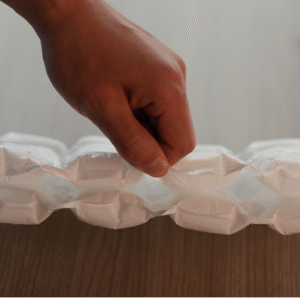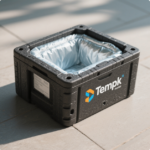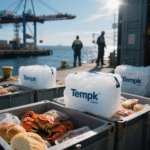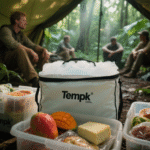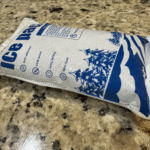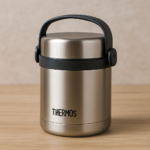Pack de gel vs glace carbonique: Quelle solution de chaîne du froid convient le mieux à votre envoi?
Lors de l'expédition de produits sensibles à la température, le choix de la solution de refroidissement—packs de gel ou glace carbonique—peut avoir un impact significatif sur la sécurité de votre envoi, coût, et les performances. Cet article détaille les principales différences entre ces deux options, vous aidant à décider lequel est idéal pour vos besoins en matière de chaîne du froid 2025.
-
Le contrôle de la température capacités des packs de gel et de la neige carbonique
-
Considérations relatives aux coûts pour les deux options, y compris la réutilisabilité et l’impact environnemental
-
Le problèmes de sécurité associé à chaque solution
-
Les meilleurs scénarios d’utilisation de packs de gel et de glace carbonique dans le transport sous chaîne du froid
Que sont Packs de gel et glace carbonique?
Packs de gel: Un aperçu
Packs de gel sont flexibles, solutions de refroidissement réutilisables contenant un gel non toxique à l'intérieur d'un boîtier en plastique. Ils fonctionnent en maintenant une température modérée, généralement entre 32°F et 50°F (0° C à 10 ° C), les rendant adaptés à produits réfrigérés comme la nourriture, produits de beauté, et produits pharmaceutiques qui nécessitent une réfrigération mais pas de congélation.
Glace sèche: Un aperçu
Glace sèche, à partir de dioxyde de carbone surgelé (CO2), se sublime à -109.3°F (-78.5°C), le rendre idéal pour produits surgelés comme la viande, fruit de mer, et des échantillons biologiques. C'est l'option idéale lorsque les produits nécessitent des températures extrêmement basses pendant de longues durées..
Comment les packs de gel et la glace carbonique se comparent-ils?
Plage de température: Ce qui garde vos produits au frais?
-
Glace sèche: Idéal pour les températures glaciales, garder les objets à sous zéro niveaux.
-
Packs de gel: Idéal pour un refroidissement modéré, généralement en maintenant les températures entre 32°F et 50°F (0° C à 10 ° C).
Durée: Combien de temps durent-ils?
-
Glace sèche: Se sublime dans le temps, offrant généralement une durée de refroidissement plus courte à moins d'être emballé efficacement.
-
Packs de gel: Fournir plus longtemps, refroidissement plus lent mais ne peut pas atteindre les températures extrêmes offertes par la neige carbonique.
Sécurité et manipulation: Ce qui est plus sûr pour votre équipe?
-
Packs de gel: Sûr au toucher et à la manipulation, sans équipement spécial nécessaire.
-
Glace sèche: Nécessite des gants et une ventilation adéquate en raison du froid extrême et du risque de Accumulation de CO2, ce qui peut être dangereux dans les espaces clos.
Comparaison des coûts: Ce qui est plus économique?
| Solution de refroidissement | Coût initial | Réutilisabilité | Frais d'expédition | Rentabilité globale |
|---|---|---|---|---|
| Packs de gel | Inférieur | Réutilisable | Inférieur | Rentable pour les expéditions à court terme |
| Glace sèche | Plus haut | À usage unique | Plus haut | Cher pour les expéditions à long terme |
-
Packs de gel sont un plus solution rentable pour les entreprises recherchant un refroidissement à court terme sans avoir besoin de températures ultra basses.
-
Glace sèche est généralement plus cher dès le départ et est un produit à usage unique, ce qui le rend plus adapté aux expéditions nécessitant des températures ultra-basses pendant de longues périodes.
Problèmes de sécurité: Ce qui est plus sûr à manipuler?
-
Packs de gel: Plus sûr pour la manipulation, sans émissions toxiques ni risques de grand froid. Ils peuvent être touchés et réutilisés en toute sécurité.
-
Glace sèche: Nécessite une manipulation spéciale. Gelure peut survenir lors d'un contact direct, et la neige carbonique peut déplacer l'oxygène dans les espaces confinés, pouvant provoquer une suffocation.
Quand devriez-vous utiliser des packs de gel?
Packs de gel sont parfaits pour:
-
Expéditions à court terme où le contrôle de la température n’est pas critique
-
Produits qui ont besoin refroidissement modéré (Par exemple, nourriture non périssable, produits de beauté, médicaments)
Quand la glace carbonique est-elle la meilleure option?
Glace sèche est essentiel quand:
-
Expédition aliments surgelés comme la viande, fruit de mer, ou glace
-
Manutention échantillons biologiques ou médicaments qui nécessitent des températures extrêmement basses
-
Transporter des marchandises sur des distances plus longues ou durées d'expédition prolongées
Tendances émergentes dans le transport sous chaîne du froid: À quoi s'attendre dans 2025
À mesure que l'industrie de la chaîne du froid évolue, plusieurs innovations améliorent l’efficacité et la durabilité des solutions de refroidissement:
-
Alternatives durables: Les packs de gel écologiques et les emballages biodégradables gagnent en popularité.
-
Technologies de surveillance avancées: Les systèmes de surveillance de la température en temps réel alimentés par l'IoT garantissent un meilleur suivi et une meilleure conformité.
-
Matériaux à changement de phase (PCMS): Ces matériaux offrent contrôle constant de la température pendant des périodes plus longues, devenir une alternative viable aux packs de gel et à la glace carbonique.
Questions fréquemment posées
Q1: Quelle solution dure plus longtemps : packs de gel ou neige carbonique?
-
La glace carbonique a tendance à durer plus longtemps, spécialement pour les températures ultra basses, tandis que les packs de gel sont plus efficaces pour refroidissement modéré sur une période plus longue.
Q2: Les packs de gel sont-ils sans danger pour les expéditions de nourriture?
-
Oui, les packs de gel sont sans danger pour l'expédition de nourriture, en particulier non périssable les articles qui doivent rester au frais, mais pas gelé.
Q3: Puis-je utiliser de la glace carbonique pour les articles réfrigérés?
-
La glace carbonique n'est pas recommandée pour les articles réfrigérés car elle fournit extrêmement froid. Les packs de gel sont plus adaptés pour garder les articles au frais sans les congeler.
Conclusion et recommandations
Choisir entre packs de gel et glace carbonique dépend des besoins de température de votre envoi. Packs de gel sont parfaits pour un refroidissement modéré et sont plus rentable pour les expéditions à court terme. Cependant, glace carbonique est nécessaire pour les expéditions nécessitant des températures ultra-basses et des durées plus longues. En évaluant votre type de produit et vos conditions d'expédition, vous pouvez prendre une décision éclairée.
Astuce exploitable: Si votre entreprise est nouvelle dans la logistique de la chaîne du froid, commencez avec des packs de gel pour les produits non congelés et expérimentez avec de la neige carbonique pour ceux qui ont besoin d'un froid extrême.
À propos du tempk
À Rotation, nous sommes spécialisés dans la fourniture de solutions innovantes en matière de chaîne du froid pour tous vos besoins d'expédition. Nos produits, y compris les packs de gel et la glace carbonique, sont conçus pour maintenir le intégrité de vos produits pendant le transit. Nous priorisons durabilité et économie dans toutes nos solutions.
Pour des conseils d'experts, contactez-nous aujourd'hui!






